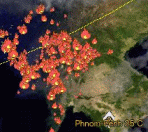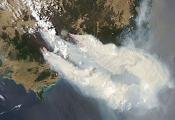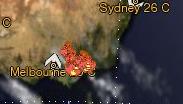Scale:
fire brightness in Kelvin >310: The
data updates for all continents happen every 3 hours, depending on the
overhead passes of the satellite. Wednesday, 15. August 2007 There is a problem with the huge number of fires. The number of global fires is now over 26.000. My server is having problems with this, because the position of each fire must be computed, to be displayed at the correct place. This is not so bad as the problems, which our Earth is experiencing, because of this. But you may experience delays in the update of the maps from my site. As a race we will feel the effects of these fires a little bit later, of course. It is only the question if the global dimming from the smoke will balance the effects of the global warming, from the release of carbon dioxide through the fires??? |
||||||||||||||||||
|
| A great thanks goes to all the programmers and volunteers around the globe whose work makes this page possible, especially Hari Nair of http://xplanet.sourceforge.net/, Hans Ecke and Michael Dear. All rights acknowledged. | |
 This
work is licensed under a
Creative
Commons Attribution-NonCommercial-ShareAlike 2.0 Germany License.
This
work is licensed under a
Creative
Commons Attribution-NonCommercial-ShareAlike 2.0 Germany License.
"Our Planet Earth From Space" concept and code implementation - Copyright Erich Habich © 2003-2004. The images on this website are offered under a Creative Commons Lizenz, the limitation being that you must not download the same image repeatedly in intervals of more often than once every 20 min. Questions ?: Click here to send me an email |


 The smoke haze choking northern Thailand is caused by dry season stubble burning, forest fires and wood-fired cooking.
The smoke haze choking northern Thailand is caused by dry season stubble burning, forest fires and wood-fired cooking.  Australian monster bushfires have generated the power of more than 100 atomic bombs and pumped out millions of tonnes of pollution, greenhouse gas and toxic clouds. CSIRO atmospheric scientist Mick Meyer said the fires generated 2.5 million tonnes of carbon monoxide; 300,000 tonnes of volatile organic compounds such as benzene, formaldehyde and hydrocarbons; 85,000 tonnes of methane; 64,000 tonnes of nitrogen oxides; and 59,000 tonnes of smoke.
Australian monster bushfires have generated the power of more than 100 atomic bombs and pumped out millions of tonnes of pollution, greenhouse gas and toxic clouds. CSIRO atmospheric scientist Mick Meyer said the fires generated 2.5 million tonnes of carbon monoxide; 300,000 tonnes of volatile organic compounds such as benzene, formaldehyde and hydrocarbons; 85,000 tonnes of methane; 64,000 tonnes of nitrogen oxides; and 59,000 tonnes of smoke. 